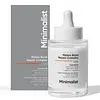What's inside
What's inside
 Key Ingredients
Key Ingredients

 Benefits
Benefits

 Concerns
Concerns

 Ingredients Side-by-side
Ingredients Side-by-side

Cyclopentasiloxane
EmollientParaffinum Liquidum
EmollientDimethicone
EmollientArgania Spinosa Kernel Oil
EmollientAlanine
MaskingArginine
MaskingAspartic Acid
MaskingButylene Glycol
HumectantCysteine
AntioxidantGlutamic Acid
HumectantGlycine
BufferingHistidine
HumectantIsoleucine
Skin ConditioningLeucine
Skin ConditioningLysine
Skin ConditioningMethionine
Skin ConditioningPhenylalanine
MaskingProline
Skin ConditioningSerine
MaskingThreonine
Tyrosine
MaskingValine
MaskingGlycyrrhiza Glabra Root Extract
BleachingHydrolyzed Collagen Extract
Skin ProtectingHydrolyzed Keratin
HumectantWater
Skin ConditioningEthylhexyl Methoxycinnamate
UV Absorber1,2-Hexanediol
Skin ConditioningPhenoxyethanol
PreservativeEthylhexylglycerin
Skin ConditioningParfum
MaskingCyclopentasiloxane, Paraffinum Liquidum, Dimethicone, Argania Spinosa Kernel Oil, Alanine, Arginine, Aspartic Acid, Butylene Glycol, Cysteine, Glutamic Acid, Glycine, Histidine, Isoleucine, Leucine, Lysine, Methionine, Phenylalanine, Proline, Serine, Threonine, Tyrosine, Valine, Glycyrrhiza Glabra Root Extract, Hydrolyzed Collagen Extract, Hydrolyzed Keratin, Water, Ethylhexyl Methoxycinnamate, 1,2-Hexanediol, Phenoxyethanol, Ethylhexylglycerin, Parfum
Caprylic/Capric Triglyceride
MaskingCocos Nucifera Oil
MaskingIsoamyl Laurate
EmollientPentylene Glycol
Skin ConditioningMaleic Acid
Buffering2-Tert-Butylcyclohexanol
PerfumingArgania Spinosa Kernel Oil
EmollientSqualane
EmollientGlycine Soja Hull
AbrasiveZea Mays Oil
EmulsifyingCysteine
AntioxidantLeucine
Skin ConditioningIsoleucine
Skin ConditioningPhenylalanine
MaskingArginine
MaskingTransglutaminase
Skin ConditioningDaucus Carota Sativa Root Extract
Skin ConditioningTocopherol
AntioxidantParfum
MaskingBHT
AntioxidantCaprylic/Capric Triglyceride, Cocos Nucifera Oil, Isoamyl Laurate, Pentylene Glycol, Maleic Acid, 2-Tert-Butylcyclohexanol, Argania Spinosa Kernel Oil, Squalane, Glycine Soja Hull, Zea Mays Oil, Cysteine, Leucine, Isoleucine, Phenylalanine, Arginine, Transglutaminase, Daucus Carota Sativa Root Extract, Tocopherol, Parfum, BHT
Ingredients Explained
These ingredients are found in both products.
Ingredients higher up in an ingredient list are typically present in a larger amount.
You may know this ingredient as argan oil. Argan Oil has antioxidant, hydrating, and soothing properties.
Studies have shown argan oil can help fight again radical damage from the sun. This makes it effective at preventing hyperpigmentation.
Large amounts of vitamin E found in argan oil helps the skin retain water. Argan oil also contains fatty acids such as linoleic acid, oleic acid, and palmitic acid. It is also a good source of lipids.
Another benefit of argan oil is skin-soothing. It can help reduce inflammation-related skin symptoms.
Argan Oil is effective at regulating sebum production in pores. This can make it effective at treating hormonal acne.
Traditionally, argan oil was used for its antibacterial and antifungal properties. However, argan oil contains fatty acids that may make it not fungal-acne safe.
Argan Trees are native to Morocco.
Learn more about Argania Spinosa Kernel OilArginine is an amino acid that is important for human development. Your body uses is it to produce hair keratin and skin collagen.
As a cosmetic ingredient, Arginine has antioxidant properties and can also help repair damaged skin. This ingredient is derived either synthetically or from animals.
Arginine isn't fungal acne safe when used in the presence of other lipids (fats, fatty acids, oils, esters, etc). Oils and fats occur naturally within the skin, so take caution when using Arginine if you're prone to fungal acne.
Learn more about ArginineCysteine is an amino acid found in our bodies. It becomes an antioxidant when converted into gluthatione.
Once it becomes gluthatione, it prevents oxidative damage to parts of our cell. Gluthatione has also been shown to protect our skin from UV-B induced damage.
Isoleucine is an amino acid that helps reinforce our skin barrier. This amino acid plays a role in creating protein for the body.
Fun fact: Isoleucine is found in meat, fish, dairy, legumes, and nuts.
We don't have a description for Leucine yet.
Parfum is a catch-all term for an ingredient or more that is used to give a scent to products.
Also called "fragrance", this ingredient can be a blend of hundreds of chemicals or plant oils. This means every product with "fragrance" or "parfum" in the ingredients list is a different mixture.
For instance, Habanolide is a proprietary trade name for a specific aroma chemical. When used as a fragrance ingredient in cosmetics, most aroma chemicals fall under the broad labeling category of “FRAGRANCE” or “PARFUM” according to EU and US regulations.
The term 'parfum' or 'fragrance' is not regulated in many countries. In many cases, it is up to the brand to define this term.
For instance, many brands choose to label themselves as "fragrance-free" because they are not using synthetic fragrances. However, their products may still contain ingredients such as essential oils that are considered a fragrance by INCI standards.
One example is Calendula flower extract. Calendula is an essential oil that still imparts a scent or 'fragrance'.
Depending on the blend, the ingredients in the mixture can cause allergies and sensitivities on the skin. Some ingredients that are known EU allergens include linalool and citronellol.
Parfum can also be used to mask or cover an unpleasant scent.
The bottom line is: not all fragrances/parfum/ingredients are created equally. If you are worried about fragrances, we recommend taking a closer look at an ingredient. And of course, we always recommend speaking with a professional.
Learn more about ParfumPhenylalanine is an amino acid. It is a skin soothing and hydrating ingredient. Amino acids play a crucial role in wound healing and skin hydration.
This ingredient is also used to help even out skin tone due to its ability to disrupt the melanin production process.
Two structures of phenylalanine exist: L-phenylalanine and D-phenylalanine. L-phenylalanine is essential, this means our bodies cannot produce it naturally and we must get it from foods. Our bodies convert D-phenylalanine to neurotransmitters, and D-phenylalanine is found in our bodies naturally.
Some foods that contain L-phenylalanine include eggs, soybeans, beef, milk.
Learn more about Phenylalanine